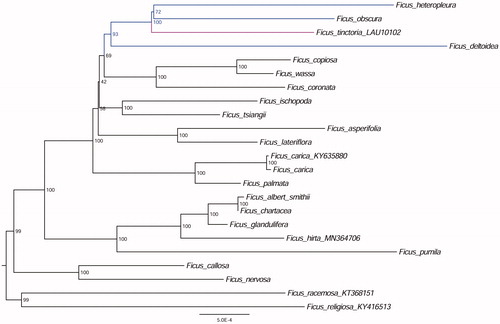Abstract
Ficus tinctoria subsp. gibbosa (Blume) Corner is a hemiepiphytic dioecious fig species of the genus Ficus in the family Moraceae. To better determine its phylogenetic location with respect to the other Ficus species, the complete plastid genome of F. tinctoria was sequenced. The whole plastome is 160,342 bp in length, consisting of a pair of inverted repeat (IR) regions of 25,859 bp, one large single-copy (LSC) region of 88,526 bp, and one small single-copy (SSC) region of 20,098 bp. The overall GC content of the whole plastome is 35.9%. Further, maximum likelihood (ML) phylogenetic analyze was conducted using 23 complete fig plastomes, which support close relationships among F. tinctoria, F. heteropleura, F. obscura, and F. deltoidea.
Ficus tinctoria subsp. gibbosa (Blume) Corner, a hemiepiphytic species distributed in tropical and subtropical areas of much of Asia, was assigned to subgenus Sycidium in the family Moraceae (Berg and Corner Citation2005). In contrast to other figs of seasonal climates, which have low production in winter, both sexes of F. tinctoria produce major crops at the coldest time of the year (Chen et al. Citation2015). This unique phenological strategy has evolved to maximize seed dispersal and establishment in seasonal climate (Chen et al. Citation2015). For a better understanding of the relationships of F. tinctoria and other fig species, it is necessary to reconstruct a phylogenetic tree based on high-throughput sequencing approaches.
Fresh young leaves of F. tinctoria in Xishuangbanna (Yunnan, China; Long. 101.2611 E, Lat. 21.9275 N, 555 m) were picked for DNA extraction (Doyle and DicksonCitation1987). The voucher was deposited at the Biodiversity Research Group of Xishuangbanna Tropical Botanical Garden (Accession Number: XTBG-BRG-10002). The whole plastid genome was sequenced following Zhang et al. (Citation2016), and their 15 universal primer pairs were used to perform long-range PCR for next-generation sequencing. The contigs were aligned with the cp genomes of relatively related species and annotated in Geneious version 4.8.
The plastome of F. tinctoria (LAU10102), with a length of 160,342 bp, was 869 bp larger than that of F. racemosa (159,473 bp, KT368151). It was also 32, 260, and 285 bp smaller than that of F. hirta (160,374 bp, MN364706), F. carica (160,602 bp, KY635880), and F. religiosa (160,627 bp, KY416513). The length of the inverted repeats (IRs), large single-copy (LSC), and small single-copy (SSC) regions of F. altissima was 25,859, 88,526, and 20,098 bp, respectively. The overall G + C content is 35.9% (LSC, 33.6%; SSC, 2.9%; IR, 42.6%).
Furthermore, based on 23 published plastid genome sequences (Bruun-Lund et al. Citation2017), we reconstructed a phylogenetic tree () to confirm the evolutionary relationship between F. tinctoria and other species with published plastomes in Ficus. Maximum likelihood (ML) phylogenetic analyses were performed base on GTR + F+R2 model in the iqtree version 1.6.7 program with 1000 bootstrap replicates (Nguyen et al. Citation2015). The ML phylogenetic tree with 42–100% bootstrap values at each node supported that F. tinctoria was closely related to and F. heteropleura, F. obscura, and F. deltoidea.
Disclosure statement
No potential conflict of interest was reported by the author(s).
Data availability statement
The data that support the finding of this study are openly available in Moraceae Chloroplast Genome Database (http://lcgdb.wordpress.com). Accession number is LAU10102.
Additional information
Funding
References
- Berg CC, Corner E. 2005. Moraceae (Ficus) in: Flora Malesiana. Series I, Vol. 17. Leiden, The Netherlands: Nooteboom H. D. National Herbarium of Netherland; p. 1–625.
- Bruun-Lund S, Clement WL, Kjellberg F, Rønsted N. 2017. First plastid phylogenomic study reveals potential cyto-nuclear discordance in the evolutionary history of Ficus L. (Moraceae). Mol Phylogenet Evol. 109:93–104.
- Chen HH, Peng YQ, Zhang Y, Corlett RT. 2015. Winter cropping in Ficus tinctoria: an alternative strategy. Sci Rep. 5:16496.
- Doyle JJ, Dickson EE. 1987. Preservation of plant samples for DNA restriction endonuclease analysis. Taxon. 36(4):715–722.
- Nguyen LT, Schmidt HA, von Haeseler A, Minh BQ. 2015. IQ-TREE: a fast and effective stochastic algorithm for estimating maximum-likelihood phylogenies. Mol Biol Evol. 32(1):268–274.
- Zhang T, Zeng CX, Yang JB, Li HT, Li DZ. 2016. Fifteen novel universal primer pairs for sequencing whole chloroplast genomes and a primer pair for nuclear ribosomal DNAs. J Syt Evol. 54(3):219–227.

